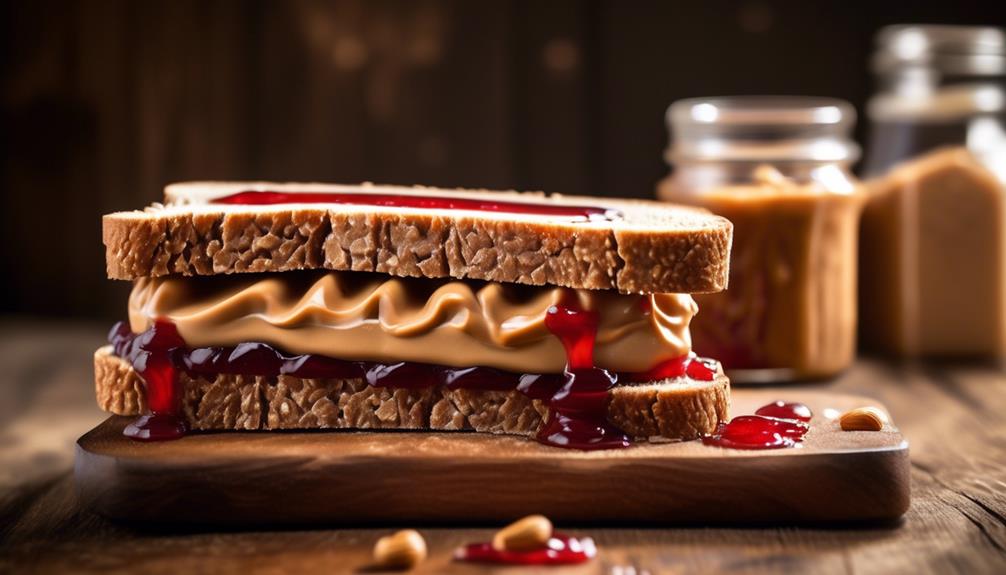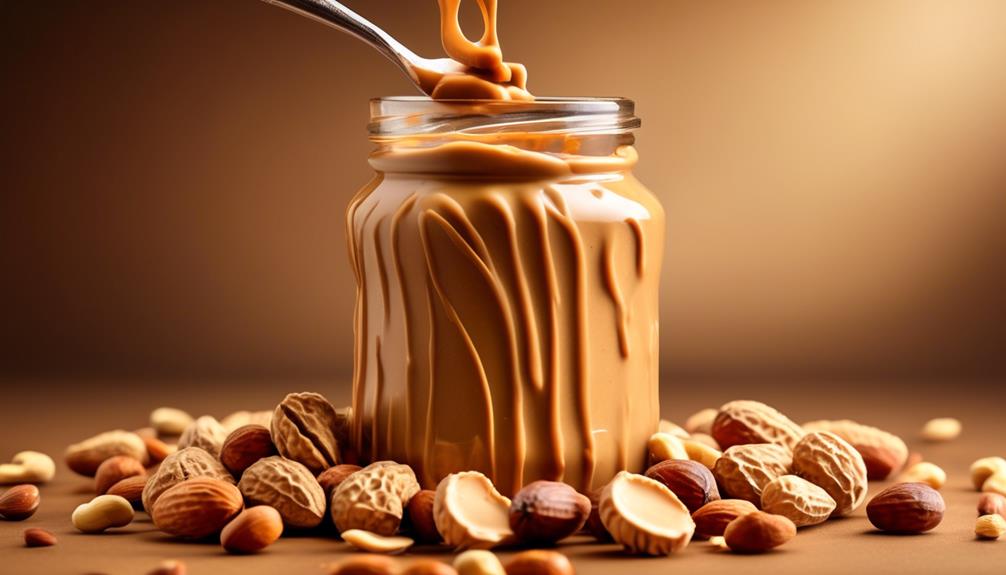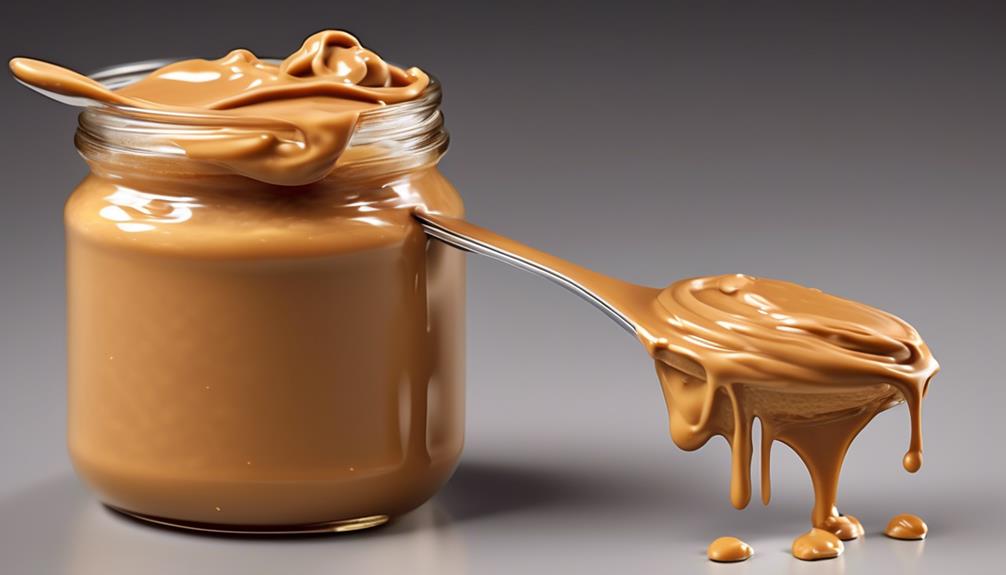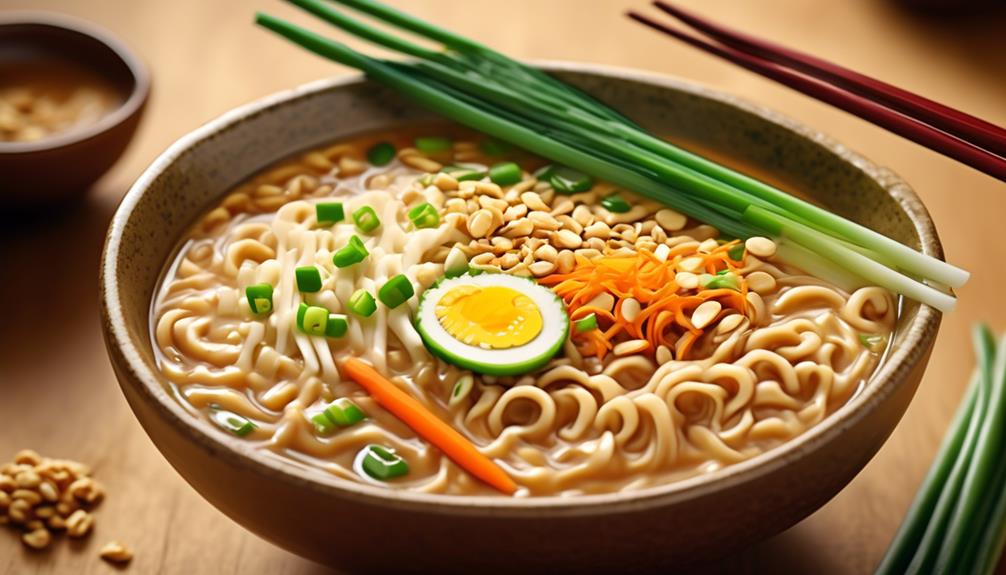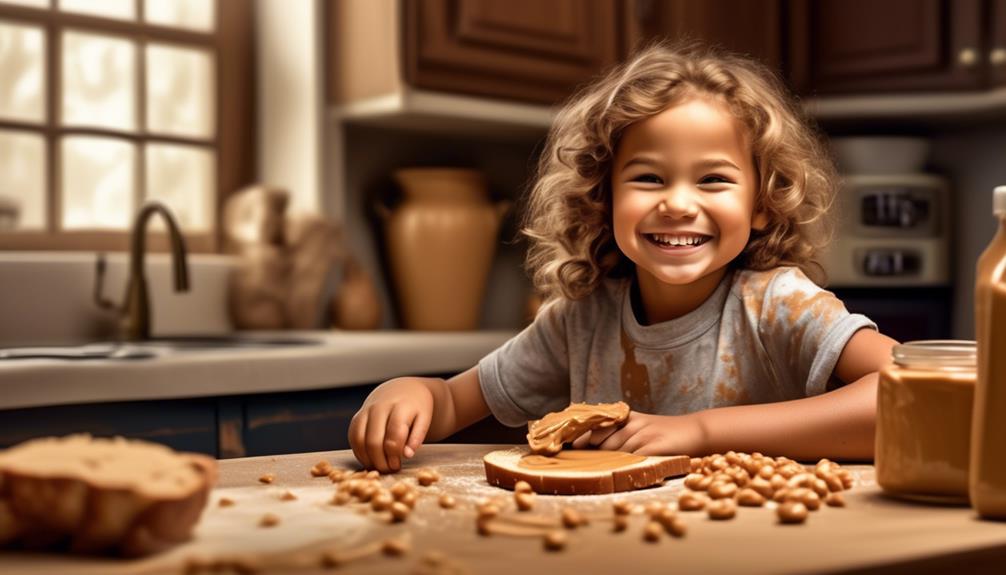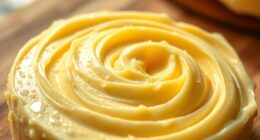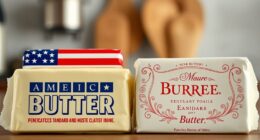Have you ever wondered why peanut butter and jam seem to go hand in hand, like two peas in a pod? The timeless combination of these two simple ingredients has intrigued and satisfied taste buds for generations.
But what is it about this classic duo that keeps us coming back for more? Join us as we explore the history, cultural significance, flavor harmony, and nutritional benefits of peanut butter and jam, and uncover the secrets behind this iconic pairing.
Key Takeaways
- The peanut butter and jelly sandwich has a rich history and cultural significance in American food culture, symbolizing comfort and home.
- Regional variations showcase the diversity of the sandwich, with different regions preferring different types of jelly and bread choices.
- Peanut butter and jam are versatile ingredients that can be used in a variety of dishes, from sauces and dressings to baked goods and smoothies.
- The combination of peanut butter and jam offers nutritional benefits, providing protein, healthy fats, essential vitamins, and minerals. However, it is important to consider portion control and choose healthier options.
History of Peanut Butter and Jam
The evolution of the peanut butter and jam combination showcases the culinary adaptation of traditional ingredients to the changing tastes and needs of society.
In 1901, the first recorded peanut butter and jelly sandwich recipe emerged, marking the beginning of a culinary phenomenon. Initially, peanut butter was paired with savory foods like cheese and celery before transitioning into a beloved sandwich spread.
The sandwich's popularity surged in the 1920s, coinciding with the availability of pre-sliced bread, making it more convenient for people to prepare. Notably, during World War II, peanut butter and jelly were included in US soldiers' military rations, further cementing the sandwich's popularity.
The combination of peanut butter and jelly became deeply ingrained in American culture, symbolizing comfort and home. This classic sandwich achieved widespread appeal among both adults and children, reflecting its versatility and widespread appeal.
The history of the peanut butter and jelly sandwich exemplifies the adaptability of culinary traditions to fit the needs and preferences of society, making it a timeless favorite.
Cultural Significance
The cultural significance of the peanut butter and jam sandwich lies in its rich history, regional variations, and its role as a symbol of childhood nostalgia.
This iconic combination of flavors has transcended class boundaries and economic hardship, becoming a unifying food choice enjoyed by generations.
Furthermore, the adaptability and enduring popularity of the PB&J sandwich reflect its continuous relevance and appeal in American food culture.
History of PB&J
Interestingly, the history of PB&J reveals its cultural significance and impact on American society. The peanut butter and jelly sandwich gained popularity in the 1920s, coinciding with the availability of sliced bread, making it a convenient meal option. Its inclusion in US soldiers' rations during World War II further solidified its place in American culture. The affordability and availability of PB&J made it a staple during hard times, such as the Great Depression, bridging economic gaps and symbolizing home and nostalgia for many. Notably, the sandwich's decline in the 1990s reflects larger societal changes, including concerns about processed foods and allergies. The Boston Cooking School Magazine's endorsement of the PB&J recipe in 1901 also contributed to its widespread popularity. Below is a table illustrating the historical timeline of peanut butter and jelly's cultural significance.
| Year | Event |
|---|---|
| 1920s | PB&J sandwich gains popularity due to sliced bread availability |
| World War II | Included in US soldiers' rations, contributing to widespread familiarity |
| Great Depression | Becomes a staple due to affordability and availability |
| 1990s | Decline in popularity mirrors societal changes and health concerns |
Regional Variations
Reflecting the diverse regional food preferences and culinary traditions, the peanut butter and jam sandwich exhibits cultural significance through its unique variations across different geographical areas.
In the United States, regional variations of the classic peanut butter and jelly sandwich abound. From the East Coast's preference for using strawberry jam to the Midwest's fondness for grape jelly, each region has its distinctive take on this beloved sandwich.
In the South, it's not uncommon to find peanut butter and jelly sandwiches served with a side of pickles, adding a sweet and tangy dimension. Additionally, variations in bread choices, such as white, wheat, or even cornbread, further illustrate the diverse culinary landscape.
These regional adaptations not only showcase the influence of local ingredients and flavors but also highlight the deep connection between food and cultural identity within different communities across the country.
Childhood Nostalgia
Indulging in a peanut butter and jelly sandwich often evokes a sense of childhood nostalgia, reminiscent of carefree days and simple pleasures. The classic PB&J sandwich holds a special place in the hearts of many, symbolizing comfort and familiarity. Here's a table to depict the emotional connection to the PB&J sandwich:
| Emotion | Description |
|---|---|
| Comfort | Feeling of security |
| Nostalgia | Remembrance of the past |
| Happiness | Joyful and carefree |
| Simplicity | Uncomplicated and easy |
| Connection | Bridging generations |
The sandwich's popularity during tough historical periods solidified its status as a cultural icon, spanning generations and evoking a sense of togetherness. Despite evolving food trends, the enduring love for this beloved sandwich showcases its timeless appeal and its ability to bring people together through shared memories of childhood.
Flavor Harmony

When it comes to flavor harmony, it's all about achieving the perfect balance of sweet, tangy, and nutty notes in a peanut butter and jam sandwich.
The creamy texture of peanut butter pairs seamlessly with the fruity sweetness of jam, creating a complementary taste profile that satisfies the palate.
From experimenting with different jam varieties to adding a hint of honey or a sprinkle of cinnamon, there are numerous ways to enhance the balanced sweetness and nuttiness of this classic combination.
Perfect Flavor Pairing
Certainly!
We consistently find that the combination of peanut butter and jam creates a perfect flavor pairing, achieving a delightful harmony of tastes. The popularity of peanut butter and jelly sandwiches is a testament to this. When spread on bread, the flavors of the peanut butter and jelly complement each other in a way that's both familiar and satisfying.
The origins of the peanut butter and jelly sandwich appeared in the early 20th century, and since then, it has become a staple in many households. The nuttiness of the peanut butter and the sweet, fruity notes of the jam create a balanced flavor profile that appeals to a wide audience.
This perfect pairing isn't only delicious but also versatile, making it suitable for any time of day.
Complementary Taste Profiles
Transitioning from the discussion of the perfect flavor pairing of peanut butter and jam, we now explore the concept of complementary taste profiles, focusing on the harmonious blend of contrasting flavors to create a balanced and pleasing combination.
The rich, savory notes of peanut butter are complemented by the bright, fruity sweetness of jam, creating a satisfying blend of flavors.
Contrasting textures of creamy peanut butter and chunky fruit preserves enhance the overall mouthfeel, adding depth to the eating experience.
Experimenting with different nut butters and fruit preserves can lead to new and delightful complementary taste profiles, expanding the flavor possibilities beyond the classic peanut butter and jam sandwiches.
Understanding complementary taste profiles can inspire creativity in combining various ingredients to create harmonious flavor experiences, contributing to a more enjoyable and diverse culinary journey.
Balanced Sweetness and Nuttiness
Achieving flavor harmony in a peanut butter and jelly sandwich involves balancing the sweetness of the jelly with the nuttiness of the peanut butter to create a well-rounded and satisfying flavor profile. When combining these two elements, the nuttiness of the peanut butter adds depth and richness to the overall sweetness of the jelly, resulting in a delightful culinary experience. Here's a helpful table to illustrate the balanced sweetness and nuttiness in a classic peanut butter and jelly sandwich recipe:
| Sweetness of Jelly | Nuttiness of Peanut Butter |
|---|---|
| Strawberry jam | Creamy peanut butter |
| Grape jelly | Chunky peanut butter |
| Raspberry preserves | Honey roasted peanut butter |
| Apricot jam | Almond butter |
The combination of sweet fruit preserves and savory peanut butter creates a harmonious and well-balanced flavor experience, making it a timeless favorite for many.
Nutritional Benefits

Peanut butter and jam offer a compelling combination of nutritional benefits that support overall health and well-being.
When considering the nutritional benefits of a peanut butter sandwich with jam, several factors come into play:
- Protein and Healthy Fats: Peanut butter provides a good source of protein and healthy fats, which can help keep you full and satisfied for longer periods.
- Essential Vitamins and Minerals: Jam contains essential vitamins and minerals from the fruit, contributing to your daily nutrient intake.
- Balanced Macronutrients: The combination of peanut butter and jam on whole grain bread offers a balanced mix of carbohydrates, fats, and proteins, making it a satisfying and energy-boosting meal or snack.
This classic combination not only offers a delightful taste but also provides a range of nutritional benefits.
Additionally, peanut butter is rich in vitamin E, magnesium, and potassium, contributing to overall heart health and muscle function.
Moreover, the convenience of this combination makes it a quick and easy way to obtain essential nutrients, making it an excellent option for those leading a busy lifestyle.
Versatility in Culinary Uses

With its adaptable nature, peanut butter and jam can be utilized in a myriad of culinary applications, adding depth and flavor to a wide range of dishes.
Peanut butter's creamy texture and rich, nutty flavor make it a versatile ingredient in both sweet and savory dishes. It can be used as a base for sauces, dressings, and marinades, adding a depth of flavor to dishes like stir-fries, satays, and salad dressings.
In baking, peanut butter adds moisture and richness to cookies, cakes, and brownies, elevating the overall taste profile. Furthermore, peanut butter can be incorporated into smoothies, oatmeal, and yogurt, providing a protein-packed and satisfying addition to breakfast or snacks.
On the other hand, jam's sweet and fruity profile makes it a perfect complement to the nuttiness of peanut butter. Together, they create a classic combination that can be used in various culinary creations.
From classic PB&J sandwiches to being swirled into oatmeal, used as a topping for pancakes, or as a filling for pastries and desserts, the versatility of peanut butter and jam extends beyond the traditional sandwich. This culinary duo offers a harmonious blend of flavors that can enhance both sweet and savory dishes, making them a staple in the kitchen for adding depth and character to a wide array of recipes.
Evolution of Sandwich Culture

The evolution of sandwich culture has been influenced by various factors, including shifts in culinary preferences and socio-economic dynamics.
The history of the Goober, particularly the peanut butter and jelly sandwich, has played a pivotal role in shaping the evolution of sandwich culture. Here are some key points to consider:
- Historical Significance: The introduction of the peanut butter and jelly sandwich during the Great Depression and World War II not only provided sustenance but also became a symbol of resilience and resourcefulness during challenging times. This historical context has contributed to the enduring popularity and cultural significance of the PB&J sandwich.
- Culinary Innovation: The evolution of sandwich culture can be attributed to the creative variations of the classic PB&J. The use of different nut butters, spreads, and bread types has transformed the sandwich into a versatile culinary delight, reflecting the evolving tastes and preferences of consumers.
- Socio-Economic Impact: The accessibility of pre-sliced bread and the rise of industrialization significantly influenced the mainstream appeal of the PB&J sandwich. Its transition from an elite delicacy to a staple food highlights the intersection of cultural and economic dynamics in shaping the evolution of sandwich culture.
The peanut butter and jelly sandwich, with its rich history and cultural significance, continues to be a beloved icon in the evolving tapestry of sandwich culture.
Global Popularity

The widespread presence of the peanut butter and jelly sandwich in various global culinary landscapes underscores its enduring appeal and integration into diverse cultural contexts.
The peanut butter and jelly sandwich, often referred to as the 'PB&J' in the United States and as the 'peanut butter and jam sandwich' in the United Kingdom, has become a staple in many households across the globe. While it's undeniably America's favorite, its popularity extends beyond North America. In countries like Sweden and the Netherlands, variations of this beloved sandwich can be found, demonstrating its global reach.
The global popularity of the peanut butter and jelly sandwich reflects its status as a beloved comfort food with widespread appeal. Its incorporation into various cuisines and culinary creations worldwide further illustrates its influence on global food culture.
This international adoption of the peanut butter and jelly sandwich highlights its ability to transcend cultural boundaries and become a cherished part of diverse culinary traditions. Its adaptability and universal appeal have firmly established it as a timeless classic in the global culinary landscape.
Marketing and Advertising Impact

The global popularity of the peanut butter and jelly sandwich has undoubtedly been influenced by its marketing and advertising impact, which has played a significant role in reinforcing its status as a beloved comfort food with widespread appeal.
- Cultural Icon: The marketing and advertising efforts have transformed the peanut butter and jelly sandwich into a cultural icon, deeply ingrained in the collective consciousness of consumers. From nostalgic commercials to strategic product placements, the visibility of this classic combination has been strategically heightened.
- Brand Loyalty: Through targeted advertising campaigns, commercial peanut butter and jelly brands have successfully cultivated a sense of brand loyalty among consumers. These efforts haven't only increased sales but also strengthened the emotional connection individuals have with their preferred peanut butter and jelly products.
- Innovation and Diversification: Marketing initiatives have also driven innovation within the peanut butter and jelly industry, leading to the introduction of diverse product variations and spin-offs. These creative advertising strategies have expanded the appeal of peanut butter and jelly to new demographics and consumer segments.
The marketing and advertising impact has undeniably played a pivotal role in shaping the widespread adoration and enduring legacy of the peanut butter and jelly sandwich.
Psychological Appeal

The flavor combination of peanut butter and jam has a powerful psychological appeal that resonates with many people.
The sweet and savory mix taps into childhood nostalgia, evoking feelings of comfort and happiness.
This psychological connection often leads to a strong emotional attachment to this classic pairing, making it a compelling choice for marketing and advertising campaigns.
Flavor Combination
Pairing certain flavors together can evoke strong emotional responses and positive associations, and the combination of peanut butter and jam exemplifies this psychological appeal.
- The sweet and salty contrast in peanut butter and jam creates a sensory experience that's both satisfying and familiar, contributing to its psychological appeal.
- This contrast triggers the brain's pleasure centers, leading to a sense of comfort and contentment.
The familiarity and nostalgia associated with peanut butter and jam can provide a sense of comfort and emotional well-being, making it a popular and enduring flavor combination.
- The psychological appeal of the peanut butter and jam flavor combination can evoke feelings of happiness, contentment, and a sense of home, making it a beloved choice for many.
The quintessential American flavor combination of peanut butter and jelly strikes a chord with many due to its ability to evoke strong emotional responses and positive associations.
Childhood Nostalgia
Flavor combinations like peanut butter and jam evoke strong emotional responses, and the psychological appeal of childhood nostalgia further enhances the positive associations with these familiar foods.
Childhood nostalgia plays a significant role in shaping our preference for peanut butter and jelly sandwiches, often linked to memories of school lunches and after-school snacks. The comfort and security provided by these classic sandwiches create a psychological connection to our early years, evoking feelings of happiness and warmth.
Revisiting these childhood foods offers a sense of continuity and emotional significance, fostering a deep connection to our past. This psychological appeal not only influences personal food preferences but also contributes to cultural and societal traditions, contributing to the enduring popularity of the beloved peanut butter and jam sandwich.
Culinary Pairing Science

Exploring the intricate science of culinary pairing allows us to understand the complex interactions between different food components and create harmonious, well-balanced combinations that enhance the overall dining experience. Culinary pairing science involves a deep understanding of flavor interactions, considering factors such as taste, texture, aroma, and appearance to create balanced and complementary pairings.
This science also delves into the chemical reactions and sensory perceptions that occur when different foods are combined, leading to a deeper understanding of flavor dynamics. By studying culinary pairing science, individuals can elevate their cooking skills, leading to the creation of well-balanced and delicious dishes.
Understanding Flavor Interactions:
- Exploring how different flavors complement or contrast with each other, such as the sweet and salty combination in peanut butter and jelly sandwiches.
Chemical Reactions and Sensory Perception:
- Investigating how ingredients interact on a molecular level, affecting taste, texture, and overall eating experience.
Creative and Innovative Combinations:
- Utilizing culinary science to experiment with unique and unexpected pairings, enhancing the dining experience for food enthusiasts.
Incorporating the principles of culinary science can lead to the creation of delightful and memorable food pairings, such as the timeless combination of peanut butter and jam.
Art of Spreading

When it comes to the art of spreading peanut butter and jam, the technique is crucial in achieving a well-balanced flavor profile.
Ensuring even coverage to the edges of the bread allows for a consistent taste in every bite.
Additionally, experimenting with different textures and consistencies can elevate the overall experience of the sandwich.
Spreading Techniques
Using a smooth and consistent motion, spread the peanut butter evenly across the bread to ensure a balanced distribution of flavor and texture. When it comes to spreading techniques for the perfect peanut butter and jelly sandwich, it's essential to consider the following:
- Pressure: Apply gentle pressure while spreading to avoid tearing the bread and ensure an even layer of peanut butter.
- *Tip*: Use a butter knife or offset spatula for better control and precision.
- Temperature: For smooth spreading, consider warming the peanut butter slightly to make it more pliable.
- *Tip*: Place the sealed peanut butter jar in warm water for a few minutes before spreading.
- Manufacturing: Understanding the manufacturing process of peanut butter can provide insights into its spreadability and texture variations.
- *Tip*: Look for natural peanut butter options with no added oils or sugars for a more authentic taste and texture.
Flavor Combinations
After mastering the spreading techniques for the perfect peanut butter and jelly sandwich, the next step is to explore the art of flavor combinations to elevate the overall taste experience. By experimenting with variations such as honey, sliced fruit, marshmallow fluff, or almond butter, one can create a unique and flavorful spread. These additions not only enhance the taste but also offer nutritional benefits.
Understanding the history of peanut butter and jelly sandwiches, including their rise in popularity during the 1920s and their inclusion in U.S. soldiers' rations in World War II, provides context to the art of spreading. The cultural significance of the sandwich, from becoming a staple during hard times to its decline in popularity in the 1990s, offers insight into its enduring appeal and the endless possibilities for flavor combinations.
Texture and Consistency
To achieve the ideal texture and consistency when spreading peanut butter and jelly, it's essential to consider the thickness of the bread and the evenness of the spread, ensuring a balanced and satisfying mouthfeel with each bite.
When it comes to the art of spreading peanut butter and jelly on bread, the following factors play a crucial role:
- Bread Thickness
Thin slices of bread may not support a heavy layer of spread, potentially leading to a soggy or messy sandwich.
Thick slices of bread can accommodate a generous spread of peanut butter and jelly while maintaining structural integrity.
- Evenness of Spread
Uneven spreading can result in pockets of intense flavor alongside areas with minimal spread, impacting the overall taste experience.
Consistent and thorough spreading ensures a harmonious integration of peanut butter and jelly flavors in every bite.
- Mouthfeel
Achieving the perfect texture and consistency guarantees a delightful and gratifying sensation with each bite of the peanut butter and jelly sandwich.
Iconic Pair in Literature and Media

The iconic pairing of peanut butter and jam has permeated literature and media, becoming a timeless symbol of comfort and simplicity. In literature, this classic duo has been used to evoke nostalgia, innocence, and the simple pleasures of life. From children's books to literary classics, references to the peanut butter and jelly sandwich abound, creating a sense of relatability and warmth for readers. In media, this iconic pair has been featured in countless films, TV shows, and advertisements, often symbolizing the bond between characters or the familiarity of home. The enduring presence of the peanut butter and jam sandwich in literature and media speaks to its status as a cultural touchstone, representing not only a delicious snack but also a powerful symbol of togetherness and enduring simplicity.
| Literature | Media |
|---|---|
| References to PB&J in | PB&J used as a symbol of |
| books, poems, and stories | bonding, comfort, and |
| across various genres | nostalgia in films, TV |
| shows, and advertisements |
Health Considerations

Consider watching portion sizes when consuming the classic peanut butter and jam sandwich, as it can be calorie-dense. When indulging in this beloved combination, it's important to be mindful of the overall caloric intake, especially for those watching their weight.
To make this iconic sandwich a bit healthier, one could opt for whole grain bread, which provides added fiber and nutrients, contributing to a more balanced meal. Additionally, choosing natural peanut butter without added sugars or oils reduces the intake of unnecessary additives, aligning with the recommendations of the National Peanut Board.
Another health-conscious choice is to use lower sugar or sugar-free fruit preserves or spreads to lessen the overall sugar content of the sandwich. By making these simple adjustments, one can enjoy the classic pairing while being more health-conscious.
It's also crucial to consider potential allergies, particularly nut allergies, and to be sensitive to dietary restrictions by offering suitable alternatives. Overall, being mindful of these health considerations allows individuals to savor the timeless delight of peanut butter and jam while maintaining a balanced diet.
Future of PB&J

Looking ahead to the future of PB&J, innovative variations using different types of nut butters and alternative spreads like cream cheese or Nutella are likely to become more prominent. The classic peanut butter and jelly sandwich may see a culinary evolution as creative additions such as honey, sliced fruit, or marshmallow fluff are incorporated for unique flavor profiles.
In fact, with the growing interest in gourmet foods, the future of PB&J could also involve gourmet versions and PB&J-inspired desserts and snacks. Chefs and food enthusiasts are expected to explore new ways to enjoy this timeless combination, expanding its potential beyond the traditional sandwich.
Moreover, as societal and dietary preferences change, the future of PB&J may lean towards healthier and sustainable options, potentially incorporating gluten-free bread or organic, natural nut butters and fruit preserves.
With advancements in food technology and meal delivery services, the future of PB&J may also involve convenient, ready-to-assemble kits or innovative cooking tricks to enhance the overall experience of preparing and enjoying a PB&J sandwich.
The possibilities are endless as we reimagine the future of this beloved culinary creation.
Frequently Asked Questions
Why Do Americans Eat Peanut Butter and Jam?
We eat peanut butter and jam because it's a convenient, beloved meal option. It gained popularity during the Great Depression and was included in soldiers' rations during World War II.
This sandwich provides significant calories, fats, carbohydrates, and proteins, making it a substantial and filling meal. It's a symbol of home, enjoyed by both adults and children, and bridges economic gaps in our society.
Despite changes in food trends, it remains a favorite, offering nostalgia and comfort.
Why Is Peanut Butter and Jelly so Good Together?
We find peanut butter and jelly so good together because the creamy, nutty peanut butter perfectly complements the sweet, tangy jelly. The combination creates a satisfying mouthfeel and a delightful flavor contrast.
Additionally, it provides a good balance of protein, healthy fats, and carbohydrates, making it a satisfying and nourishing snack or meal.
The nostalgic and comforting association of peanut butter and jelly sandwiches further adds to its appeal for people of all ages.
Why Was the Peanut Butter and Jelly Sandwich Invented?
The peanut butter and jelly sandwich was invented as a convenient, tasty meal option. It became popular due to its association with childhood and nostalgia, as well as being part of US soldiers' rations during World War II.
Initially considered an upper-class treat, it became a staple during hard times like the Great Depression. Today, there are variations using different nut butters, alternative spreads, and creative additions like fruits or marshmallow fluff.
What Does the Peanut Butter and Jelly Symbolize?
Peanut butter and jelly symbolize comfort, simplicity, and inclusivity. It represents a nostalgic and affordable food choice, enjoyed across generations.
This classic combination reflects the adaptability and cultural fusion of food, evolving to include various ingredients and variations. Its popularity during economic hardship showcases its accessibility and appeal to people from all walks of life.
Conclusion
In conclusion, the timeless combination of peanut butter and jam has a rich history, cultural significance, and nutritional benefits. Its flavor harmony and versatility in culinary uses make it a beloved favorite.
The art of spreading and its iconic presence in literature and media further solidify its place in our hearts and stomachs.
As we consider the future of PB&J, we can't help but wonder: can any other sandwich truly compare?
